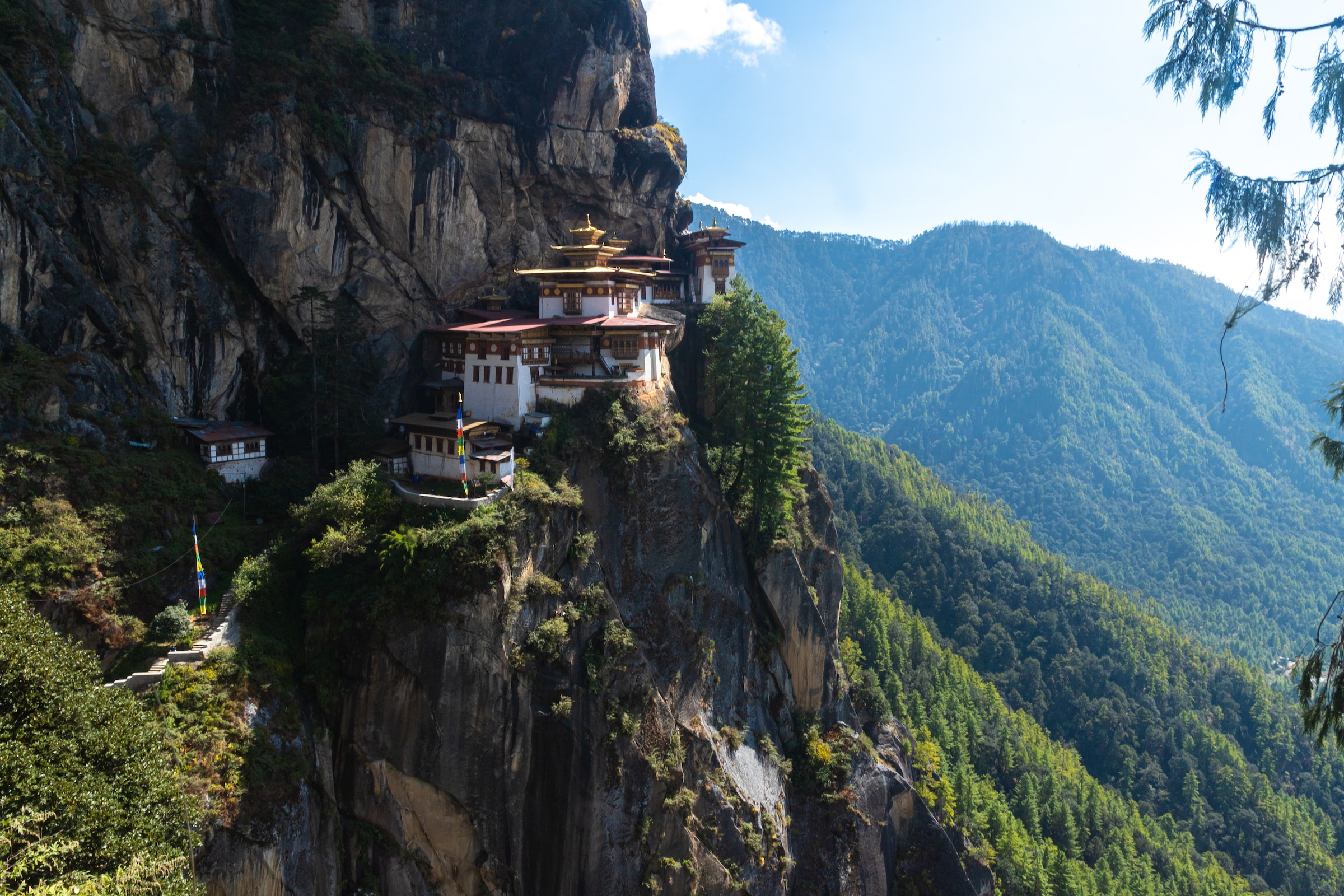Bhutan, the Land of the Thunder Dragon, captivates its visitors with pristine natural beauty, a fascinating array of cultural displays and distance from the masses of tourists that would usually flock towards destinations as beautiful as this small mountain kingdom. With the global tourism industry being confronted with great sustainability challenges, the need to mend the gap between sustained economic growth and commitment to preserving natural heritage has intensified drastically in recent years. Bhutan, with its unique approach to sustainable tourism, presents a shining example of a solution that not only paves the way to a greener future, but also ensures the well-being of its people and natural treasures alike.
Gross National Happiness: Beyond Economic Metrics
In a world in which even the most remote areas have their stake in the race of globalization, the Himalayan nation of Bhutan has consciously chosen to prioritize happiness and well-being over material wealth and an unsustainable boom in economic growth and material wealth.
The country’s philosophy is centered around “Gross National Happiness” – a term pioneered by His Majesty the Fourth King of Bhutan, Jigme Singye Wangchuk in the 1970s.
This index takes into account 33 different indicators for holistic, sustainable development and is built upon four pillars: good governance, sustainable socio-economic development, cultural preservation, and environmental conservation. These four pillars have since been expanded into nine domains in order to encompass a more comprehensive range of values which are fundamental to the well-being of the Bhutanese people, showcasing the principles of a life well led according to the GNH concept.
Moreover, the United Nations have included the Gross National Happiness Index in their 2030 Agenda for Sustainable Development, categorizing GNH as a “Goal 8” (decent work and economic growth) measure.
Pay Per Day – Bhutan’s Sustainable Development Fee
While European tourist hot spots are still largely exploring the concept of implementing daily fees to curb the daily influx of visitors, Bhutan made this a reality back in 1974 when tourists were first permitted to enter the secluded country, bringing with its high cost to enter the notion of being earth’s “last Shangri-La”.
Recognizing the fragility of its ecosystems and the crucial need of preserving cultural authenticity, the country has remained firm on its unique “high value, low volume” tourism policy since 1974, with a total of merely 287 visitors entering the country during that year.
Due to the pre-existing consciousness of the importance of a balanced approach to growth, the government imposed strict limits on visitor numbers and, starting in 1991, required visitors from overseas to pay a fee of at least $250 per day to cover the cost of accommodations, meals, a mandatory tour guide, including the $65 “Sustainable Development Fee” (SDF).
The Cost of “High Value” Experiences
Fast forward to September 2022 when the country re-opened its borders for international tourism after the COVID-19 pandemic, the government of Bhutan has largely overhauled its tourism system, wiping the prior obligation for visitors to be part of a guided tour but drastically increasing the overall cost for a trip to the country.
According to Dr. Tandi Dorji, Bhutan’s foreign minister and chairman of the Tourism Council of Bhutan, the COVID-19 pandemic imposed a period of deep reflection upon the country’s leadership, leading to revised ideas regarding an efficient restructuring and operation of the tourism sector. Dr. Tandi Dorji defined the sector’s goal as aiming “to create high value experiences for visitors, and well-paying and professional jobs for our citizens.”
As a direct result of this revamp, visitors are now required to pay a sustainable development fee of $200 per night per person (aged 12+) directly to the government but will have to cover their expenses for hotels, meals, and various other activities separately. Before the pandemic, tourists had to adhere to a minimum daily spending range of $200 – $250, typically combined into tour packages covering certain expenses, including the SDF, which was still $65 at the time.
An Elitist Approach to Tourism?
Proponents of Bhutan’s $200 daily fee argue that it aligns with the country’s objective to attract “high value, low volume” tourists who can afford the fee. The revenue generated from these fees is intended to be directed toward upgrading infrastructure, protecting and preserving the environment, and creating jobs with fair wages and working conditions.
On the other hand, some critics view the increased rates as “elitist” and fear that they may adversely impact the country’s travel industry, which was naturally affected by the consequences of the COVID-19 pandemic. The country’s foreign minister defended Bhutan’s decision to triple the daily SDF (from $65 to $200), stating it caters to environmentally-conscious tourists willing to pay more for their visit. While he refuted the accusation of the policy being “elitist,” he acknowledged the need to reassess priorities, considering the pandemic’s economic impact on neighboring countries.
Unique Experiences for a Few Travelers
Bhutan’s focus on “high value, low volume” tourism naturally allows the country to attract only those willing and able to shoulder the high costs that accompany a trip to the Buddhist kingdom. The people who do, however, have the means to commit to this unique, immersing experience will not be disappointed.
During a 14 day stay, visitors will be enchanted by the majestic Himalayas, Bhutan’s fascinating cultural sights such as the well-known Paro Taktsang monastery, and the rich, community-based activities of the local people.
Green Kingdom
Central to Bhutan’s sustainability agenda is its tireless dedication to environmental conservation. With an ambitious target of maintaining at least 60% forest cover, Bhutan has become one of the world’s most forested countries. Its lush landscapes bear witness to this commitment.
Additionally, Bhutan has banned plastic bags since 1999, a remarkable feat that has minimized plastic waste and inspired other nations, such as certain Indian states, to follow suit. Bhutan’s focus on renewable energy, particularly hydropower, has not only met its domestic energy needs but also allowed the country to become the world’s first and only carbon negative country.
Culture Unplugged
Preserving its diverse cultural heritage is another one of the kingdom’s prime objectives. The government has implemented initiatives such as the “Living Museum” concept, offering visitors an authentic experience of Bhutanese culture. Located in the country’s capital of Thimphu, “Simply Bhutan” is an immersive “living” museum that allows visitors to dive into various aspects of local culture.
Traditional arts, architecture, and festivals are pivotal in showcasing the country’s identity. By promoting cultural preservation, Bhutan ensures that future generations inherit an intact heritage and that visitors leave with an appreciation for its customs and traditions based on observation and first-hand knowledge.
Festivals in Bhutan are grand, colorful events, and visitors will be pleased to encounter these splendid cultural showcases taking place nearly every month of the year.
Trouble in Paradise?
While Bhutan’s sustainable tourism practices have been widely praised, challenges persist. Balancing the demands of tourism growth with environmental conservation requires a delicate equilibrium. Striking a harmonious balance between economic development and the preservation of cultural authenticity poses ongoing challenges.
The United Nations has identified specific pain points and potential inhibitors for Bhutan’s future development. The organization specifically highlighted the nation’s vulnerability to climate change and natural disasters, concerns over food security and the capacity of the national health system, and a substantial rise in unemployment rates during the pandemic.
All these factors are putting pressure on the country’s nature-dependent livelihoods and carbon-neutral commitment. However, Bhutan’s commitment to sustainability remains strong, and its experiences offer valuable lessons to the world.
Bhutan’s Lesson In Preserving People and Planet – What Can We Learn?
Bhutan’s exemplary model of sustainable tourism serves as a powerful lesson for the global travel industry, including Europe.
As we set out to navigate the challenges of sustainability and seek ways to combine the two factors of “green” and “growth”, Bhutan’s journey offers an ocean of invaluable insights. Bhutan’s commitment to Gross National Happiness, community empowerment, and environmental conservation demonstrates a truly holistic and forward-thinking approach.
Promoting eco-friendly practices can ensure that Europe’s tourism destinations become living examples of sustainability. By adopting Bhutan’s balanced approach, Europe has the potential to pioneer its own models of success in the green tourism industry: By making the preservation of the people and the planet our utmost priority, we can begin to pave the way toward a greener future for the many adventurers and generations to come.
Reviewed by Sarah Guvi, proofread by Juxhina Malaj





